display TOYOTA PROACE 2020 (in English) Owner's Manual
[x] Cancel search | Manufacturer: TOYOTA, Model Year: 2020, Model line: PROACE, Model: TOYOTA PROACE 2020Pages: 430, PDF Size: 48.01 MB
Page 46 of 430

46
Setting the time and date
You can choose to synchronise the time and date with the GPS navigation system (if fitted to your vehicle) so that these settings are adjusted automatically.
With the audio system
F Press the MENU button for access to the main menu.
F Press the "7" or "8" button to select the Personalisation-configuration menu, then confirm by pressing the "OK" button.
F Press the "5" or "6" and "7" or "8" buttons to set the date and time, then confirm by pressing the "OK" button.
F Press the "5" or "6" button to select the Display configuration menu then confirm by pressing the "OK" button.
Without audio system
F Press this button to display the following settings in turn:- hours,- minutes,- 12 or 24 hour format.With Toyota Pro Touch
With Toyota Pro Touch with
navigation system
Select the Settings menu in the upper banner of the touch screen.
Select the Settings menu in the bar of the touch screen.
F Select "Date and time".
F Select "Set time-date".
F Select "Date" or "Time".F Choose the display formats.
F Change the date and/or time using the numeric keypad.F Confirm with "OK".
F Select "System configuration".
F Press the "OPTIONS" button to go to the secondary page.
F Setting of the time and date is only available if synchronisation with the GPS is deactivated.
F Select the "Date" or "Time" tab.F Set the date and/or time using the numeric keypad.F Confirm with "OK".
Instruments
Page 48 of 430
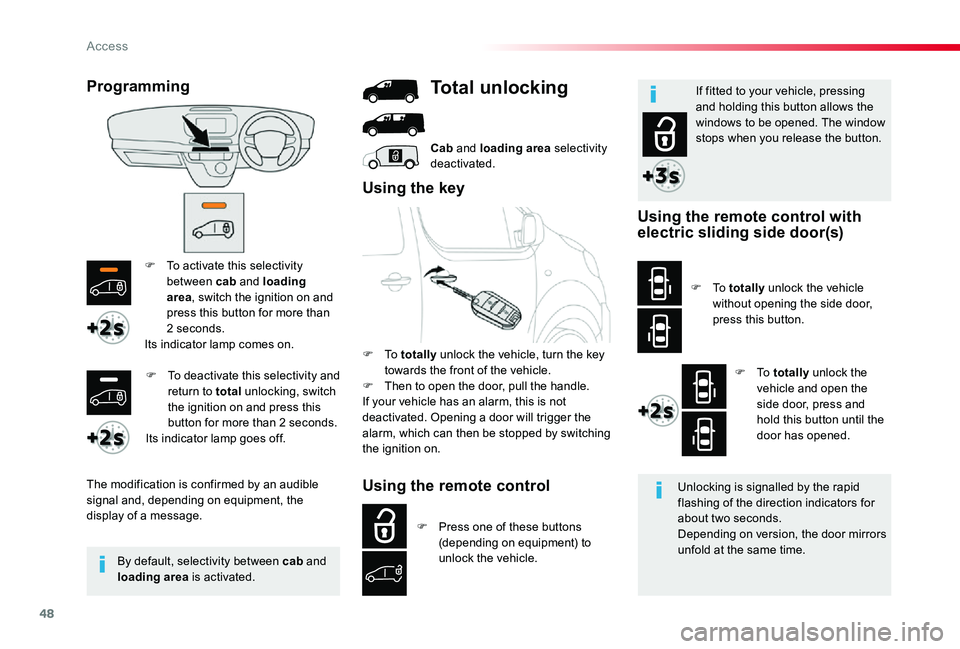
48
F To activate this selectivity between cab and loading area, switch the ignition on and press this button for more than 2 seconds.Its indicator lamp comes on.
The modification is confirmed by an audible signal and, depending on equipment, the display of a message.
F To deactivate this selectivity and return to total unlocking, switch the ignition on and press this button for more than 2 seconds.Its indicator lamp goes off.
By default, selectivity between cab and loading area is activated.
Total unlocking
Using the remote control
F Press one of these buttons (depending on equipment) to unlock the vehicle.
Unlocking is signalled by the rapid flashing of the direction indicators for about two seconds.Depending on version, the door mirrors unfold at the same time.
If fitted to your vehicle, pressing and holding this button allows the windows to be opened. The window stops when you release the button.
Using the key
Using the remote control with electric sliding side door(s)
F To totally unlock the vehicle and open the side door, press and hold this button until the door has opened.
F To totally unlock the vehicle without opening the side door, press this button.
Programming
F To totally unlock the vehicle, turn the key towards the front of the vehicle.F Then to open the door, pull the handle.If your vehicle has an alarm, this is not deactivated. Opening a door will trigger the alarm, which can then be stopped by switching the ignition on.
Cab and loading area selectivity deactivated.
Access
Page 55 of 430
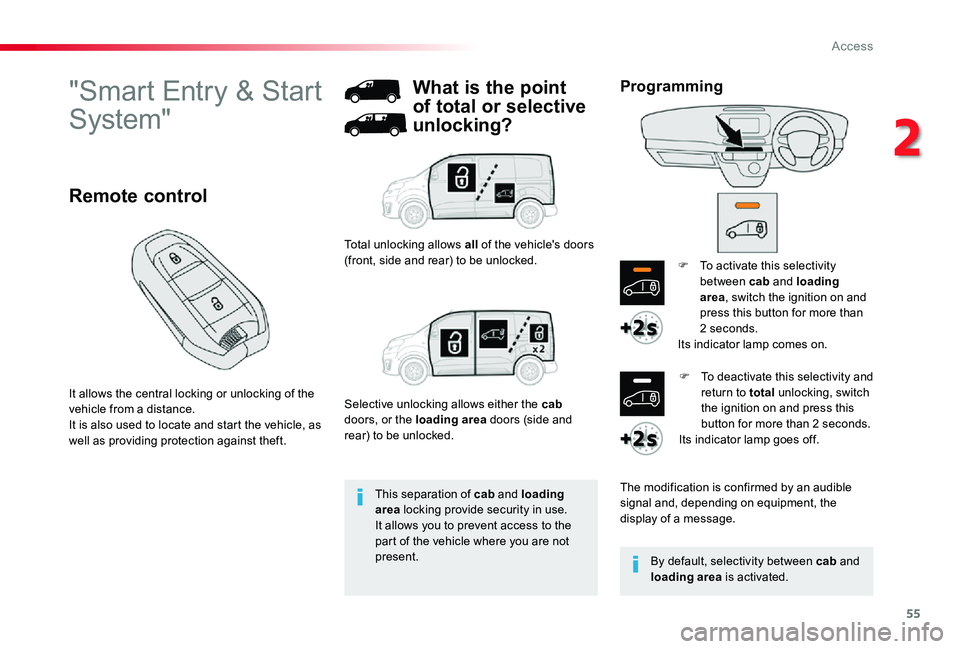
55
"Smart Entry & Start
System"
It allows the central locking or unlocking of the vehicle from a distance.It is also used to locate and start the vehicle, as well as providing protection against theft.
Remote control
This separation of cab and loading area locking provide security in use.It allows you to prevent access to the part of the vehicle where you are not present.
What is the point
of total or selective
unlocking?
Total unlocking allows all of the vehicle's doors (front, side and rear) to be unlocked.
Selective unlocking allows either the cab doors, or the loading area doors (side and rear) to be unlocked.
F To activate this selectivity between cab and loading area, switch the ignition on and press this button for more than 2 seconds.Its indicator lamp comes on.
The modification is confirmed by an audible signal and, depending on equipment, the display of a message.
F To deactivate this selectivity and return to total unlocking, switch the ignition on and press this button for more than 2 seconds.Its indicator lamp goes off.
By default, selectivity between cab and loading area is activated.
Programming
2
Access
Page 121 of 430

121
Upper storage compartment
This is located in the dashboard, behind the steering wheel.
Press the control to open the lid (depending on version) then guide it to its fully open position.To close, guide the lid then press the centre g e nt l y.Any liquid which could spill risks causing an electrical short circuit and therefore a potential fire.
12 V accessory socket(s)
(depending on version)
F To connect a 12 V accessory (maximum power: 120 Watts), lift the cover and connect a suitable adaptor.
Obser ve the maximum power rating to avoid damaging your accessory.
The connection of an electrical device not approved by Toyota, such as a USB charger, may adversely affect the operation of vehicle electrical systems, causing faults such as poor telephone reception or inter ference with displays
in the screens.
3
Ease of use and comfort
Page 122 of 430

122
Lashing rings
Loading area
fittings
Use the lashing rings on the rear floor to secure your loads.As a safety precaution in case of sharp braking, you are advised to place heavy objects as far for wards towards the cab as possible.You are advised to immobilise the load by securing it firmly using the lashing rings on the
f l o o r.
Depending on the vehicle's equipment, the various fittings below are located in the loading area.
USB port
It allows the connection of a portable device, such as a digital audio player of the iPod® type or a USB memory stick.It reads the audio files which are transmitted to your audio system and played via the vehicle's speakers.You can manage these files using the steering mounted controls or the audio system.
When a USB port is used, the portable device charges automatically.While charging, a message is displayed if the current consumption of the portable device exceeds the power rating of the port.For more information on using this equipment, refer to the Audio and
telematics section.
Ease of use and comfort
Page 128 of 430
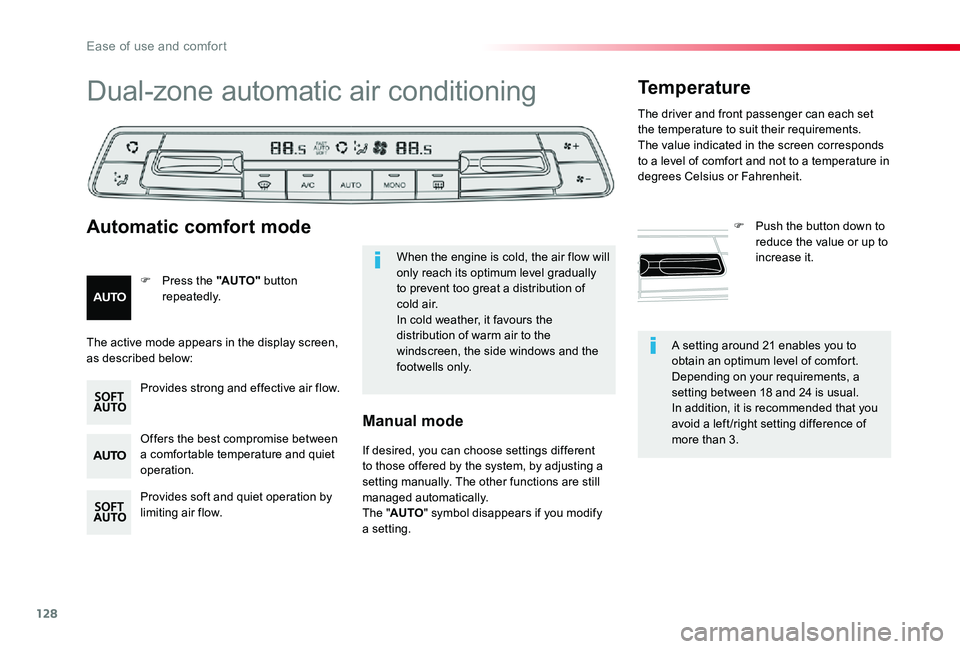
128
A setting around 21 enables you to obtain an optimum level of comfort. Depending on your requirements, a setting between 18 and 24 is usual.In addition, it is recommended that you avoid a left /right setting difference of more than 3.
Dual-zone automatic air conditioning
Offers the best compromise between
a comfortable temperature and quiet operation.
Provides soft and quiet operation by limiting air flow.
Provides strong and effective air flow.
F Press the "AUTO" button repeatedly.
Automatic comfort mode
Temperature
F Push the button down to reduce the value or up to
increase it.When the engine is cold, the air flow will only reach its optimum level gradually to prevent too great a distribution of c o l d a i r.In cold weather, it favours the distribution of warm air to the windscreen, the side windows and the footwells only.
The active mode appears in the display screen, as described below:
If desired, you can choose settings different to those offered by the system, by adjusting a setting manually. The other functions are still managed automatically.The "AUTO" symbol disappears if you modify a setting.
Manual mode
The driver and front passenger can each set the temperature to suit their requirements.The value indicated in the screen corresponds to a level of comfort and not to a temperature in degrees Celsius or Fahrenheit.
Ease of use and comfort
Page 129 of 430
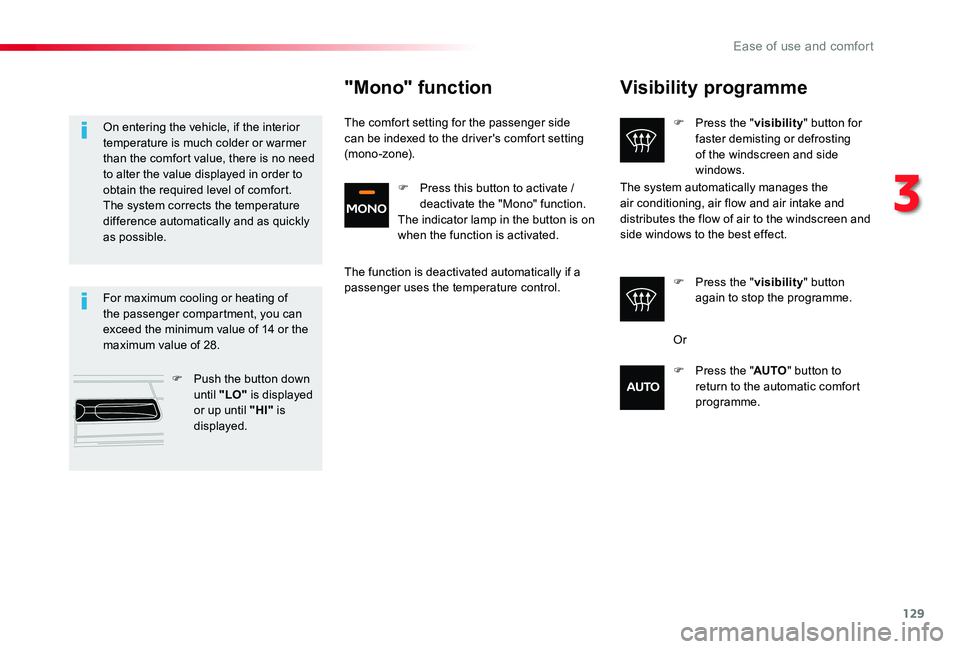
129
Visibility programme
F Press the "visibility" button for faster demisting or defrosting of the windscreen and side windows.
F Press the "visibility" button again to stop the programme.
The system automatically manages the air conditioning, air flow and air intake and distributes the flow of air to the windscreen and side windows to the best effect.
For maximum cooling or heating of the passenger compartment, you can exceed the minimum value of 14 or the maximum value of 28.
F Push the button down until "LO" is displayed or up until "HI" is displayed.
On entering the vehicle, if the interior temperature is much colder or warmer than the comfort value, there is no need to alter the value displayed in order to obtain the required level of comfort. The system corrects the temperature difference automatically and as quickly as possible.
"Mono" function
The comfort setting for the passenger side can be indexed to the driver's comfort setting (mono-zone).
The function is deactivated automatically if a passenger uses the temperature control.
Or
F Press the "AUTO" button to return to the automatic comfort programme.
F Press this button to activate / deactivate the "Mono" function.The indicator lamp in the button is on when the function is activated.
3
Ease of use and comfort
Page 138 of 430
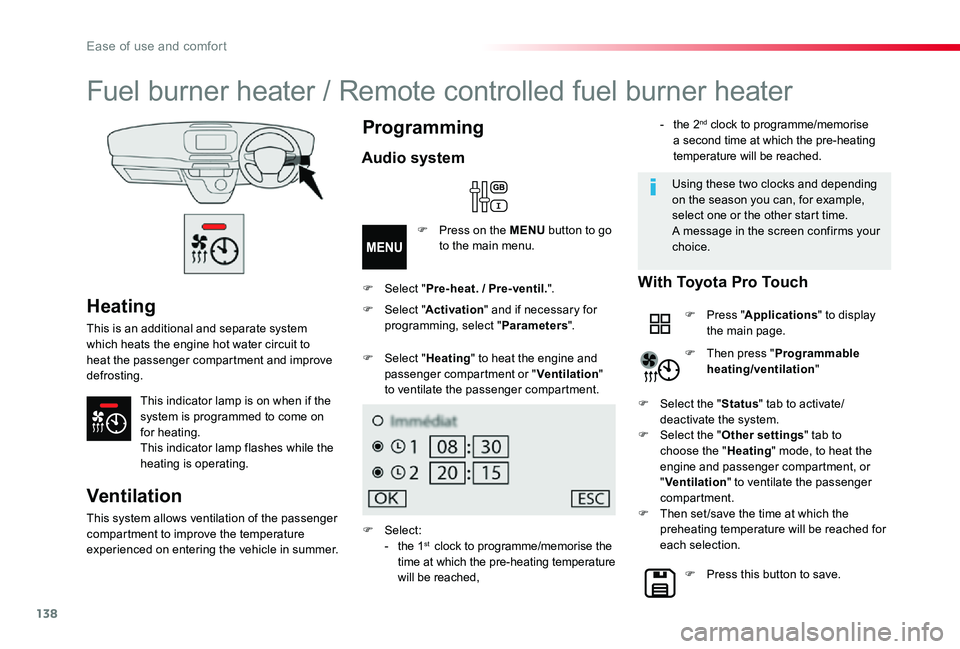
138
Heating
This is an additional and separate system which heats the engine hot water circuit to heat the passenger compartment and improve defrosting.
This indicator lamp is on when if the system is programmed to come on for heating.This indicator lamp flashes while the heating is operating.
Fuel burner heater / Remote controlled fuel burner heater
Ventilation
This system allows ventilation of the passenger compartment to improve the temperature
experienced on entering the vehicle in summer.
Programming
Audio system
F Press on the MENU button to go
to the main menu.
F Select "Pre-heat. / Pre-ventil.".
F Select "Heating" to heat the engine and passenger compartment or "Ventilation" to ventilate the passenger compartment.
F Select:- the 1st clock to programme/memorise the time at which the pre-heating temperature will be reached,
Using these two clocks and depending on the season you can, for example, select one or the other start time.A message in the screen confirms your choice.
F Select "Activation" and if necessary for programming, select "Parameters".
- the 2nd clock to programme/memorise a second time at which the pre-heating temperature will be reached.
With Toyota Pro Touch
F Press "Applications" to display the main page.
F Then press "Programmable heating/ventilation"
F Press this button to save.
F Select the "Status" tab to activate/deactivate the system.F Select the "Other settings" tab to choose the "Heating" mode, to heat the engine and passenger compartment, or "Ventilation" to ventilate the passenger compartment.F Then set /save the time at which the preheating temperature will be reached for each selection.
Ease of use and comfort
Page 149 of 430
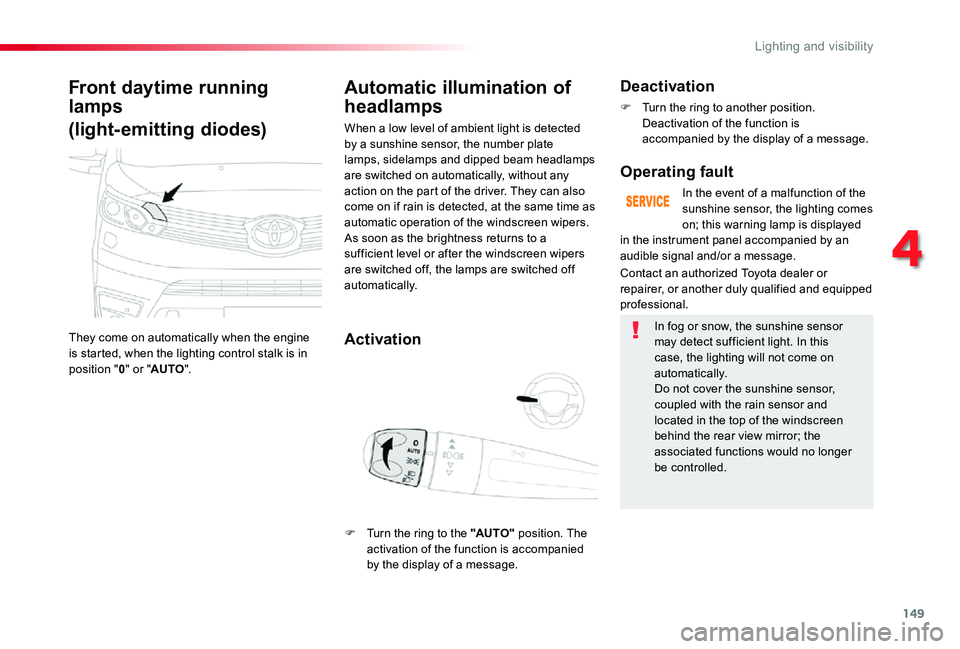
149
Front daytime running
lamps
(light-emitting diodes)
They come on automatically when the engine is started, when the lighting control stalk is in position "0" or "AUTO".
Automatic illumination of
headlamps
Activation
When a low level of ambient light is detected by a sunshine sensor, the number plate lamps, sidelamps and dipped beam headlamps are switched on automatically, without any action on the part of the driver. They can also come on if rain is detected, at the same time as automatic operation of the windscreen wipers.As soon as the brightness returns to a
sufficient level or after the windscreen wipers are switched off, the lamps are switched off automatically.
Deactivation
F Turn the ring to another position. Deactivation of the function is accompanied by the display of a message.
Operating fault
In the event of a malfunction of the sunshine sensor, the lighting comes on; this warning lamp is displayed
Contact an authorized Toyota dealer or repairer, or another duly qualified and equipped professional.
in the instrument panel accompanied by an
audible signal and/or a message.
In fog or snow, the sunshine sensor may detect sufficient light. In this case, the lighting will not come on automatically.Do not cover the sunshine sensor, coupled with the rain sensor and located in the top of the windscreen behind the rear view mirror; the
associated functions would no longer be controlled.
F Turn the ring to the "AUTO" position. The
activation of the function is accompanied by the display of a message.
4
Lighting and visibility
Page 157 of 430
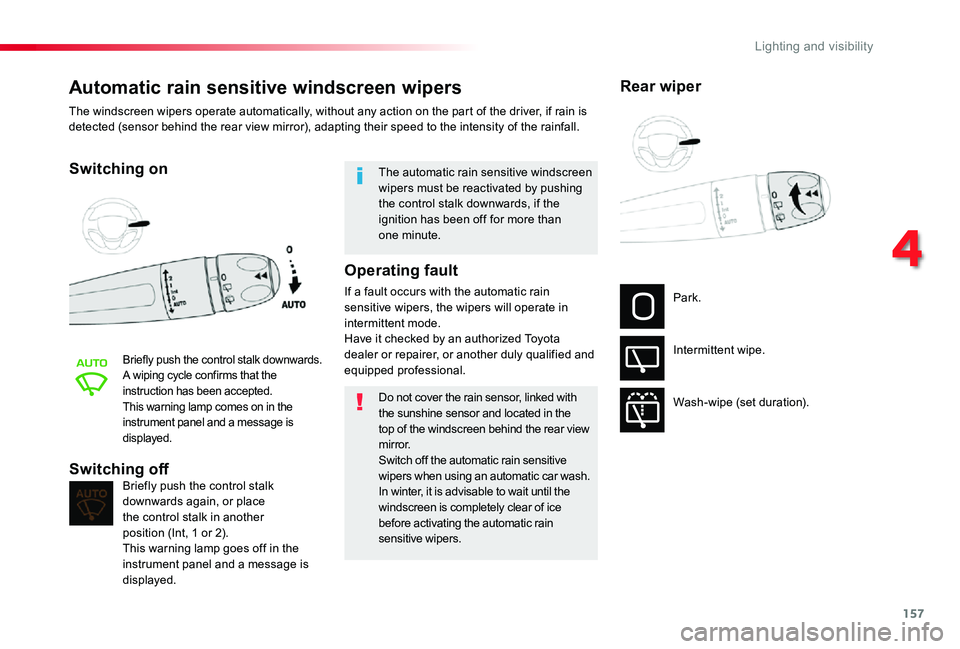
157
Automatic rain sensitive windscreen wipers
Switching on
Briefly push the control stalk downwards.A wiping cycle confirms that the instruction has been accepted.This warning lamp comes on in the instrument panel and a message is displayed.
Briefly push the control stalk downwards again, or place the control stalk in another position (Int, 1 or 2).This warning lamp goes off in the instrument panel and a message is displayed.
Switching off
The automatic rain sensitive windscreen wipers must be reactivated by pushing the control stalk downwards, if the ignition has been off for more than one minute.
The windscreen wipers operate automatically, without any action on the part of the driver, if rain is detected (sensor behind the rear view mirror), adapting their speed to the intensity of the rainfall.
Do not cover the rain sensor, linked with the sunshine sensor and located in the top of the windscreen behind the rear view m i r r o r.Switch off the automatic rain sensitive wipers when using an automatic car wash.In winter, it is advisable to wait until the windscreen is completely clear of ice before activating the automatic rain sensitive wipers.
Operating fault
If a fault occurs with the automatic rain sensitive wipers, the wipers will operate in intermittent mode.Have it checked by an authorized Toyota dealer or repairer, or another duly qualified and equipped professional.
Park.
Intermittent wipe.
Wash-wipe (set duration).
Rear wiper
4
Lighting and visibility